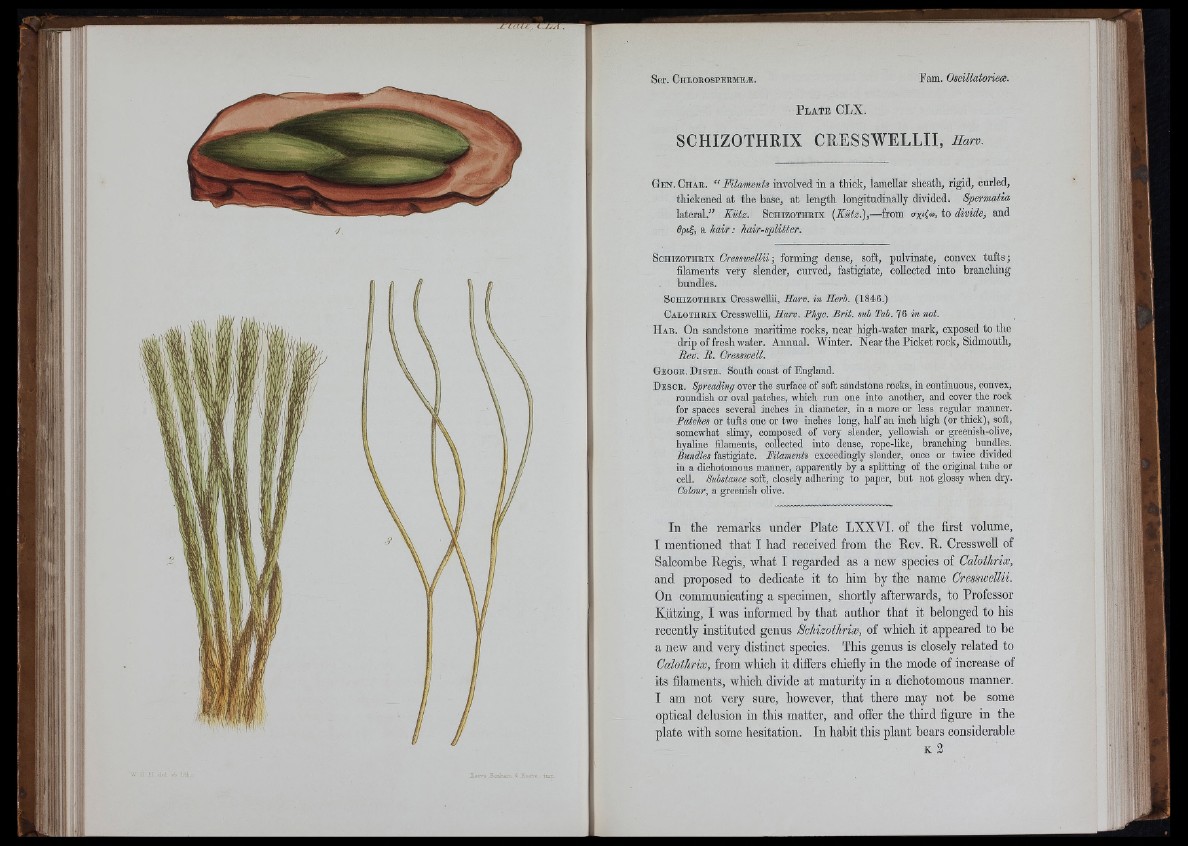
P l a t e CLX.
SCHIZOTHRIX CRESSWELLII, Harv.
G e n . Ch a r . “ Mlcements involved in a th ic k , lamellar sh ea th , rig id , curled,
th ick en ed a t th e base, a t le n g th lo n g itu d in a lly d ivided. Spermatia
la te ra l.” Kiitz. Schizo th r ix [Kiitz.),— from o-xifo), to divide, a n d
6pi^, a h a ir :
S chizo th r ix Cresswellü-, forming dense, soft, pulvinate, convex tufts;
filaments very slender, curved, fastigiate, collected into brancldng
bundles.
Schizo th r ix Cresswellü, Harv. in Herh. (1846.)
Ca lothm x Cresswellü, Harv. Fhyc. Brit, sub Tab. 16 in not.
H ab . Oh sandstone maritime rooks, near high-water mark, exposed to the
drip of fresh water. Annual. Winter. Near the Picket rook, Sidmouth,
Rev. R . Cressmell.
Geogk. D is t r . South coast of England.
D esok. Spreading over the surface of soft sandstone rocks, in continuous, convex,
roundish or oval patches, which run one into another, and cover the rock
for spaces several inches in diameter, in a more or less regular manner.
Batches or tufts one or two inches long, half an inch high (or thick), soft,
somewhat slimy, composed of very slender, yellowish or greenish-oüve,
hyaline filaments, collected into dense, rope-like, branching bundles.
Bundles fastigiate. Bilaments exceedingly slender, once or twice divided
in a dichotomous manner, apparently by a splitting of th e original tube or
cell. Substance soft, closely adhering to paper, b u t not glossy when dry.
Colour, a greenish olive.
mf
i
In the remarks under Plate LXXVI. of the first volume,
I mentioned that I had received from the Rev. R. Cresswell of
Salcombe Regis, wbat I regarded as a new species of Caloihrix,
and proposed to dedicate it to him by the name Cresswellii.
On communicating a specimen, shortly afterwards, to Professor
Kiitzing, I was informed by that author that it belonged to his
recently instituted genus Schizothrix, of which it appeared to be
a new and very distinct species. This genus is closely related to
Calothrix, from which it differs chiefly in the mode of increase of
its filaments, which divide at maturity in a dichotomous manner.
I am not very sure, however, that there may not be some
optical delusion in this matter, and offer the third figure in the
plate with some hesitation. In habit this plant bears considerable